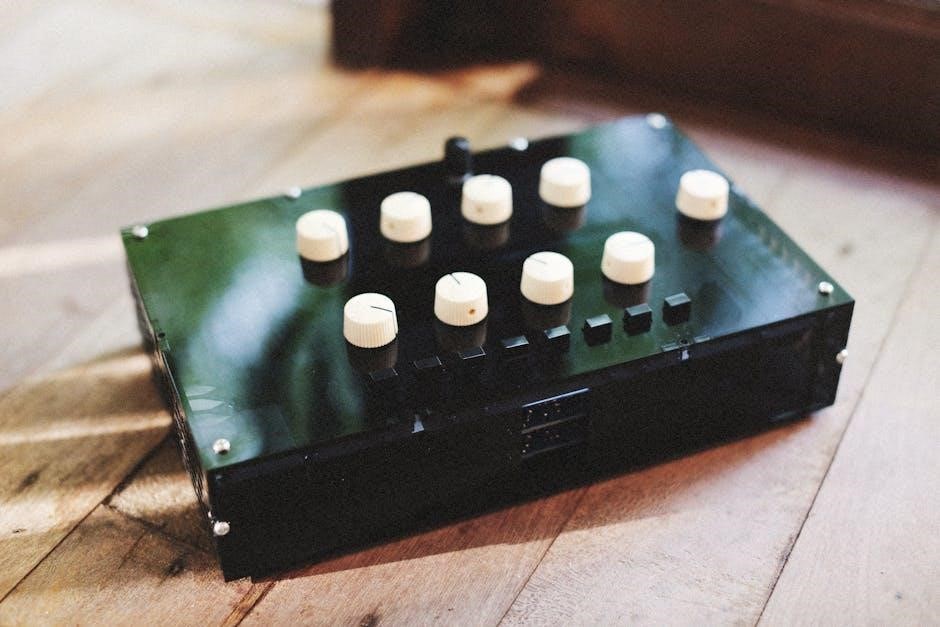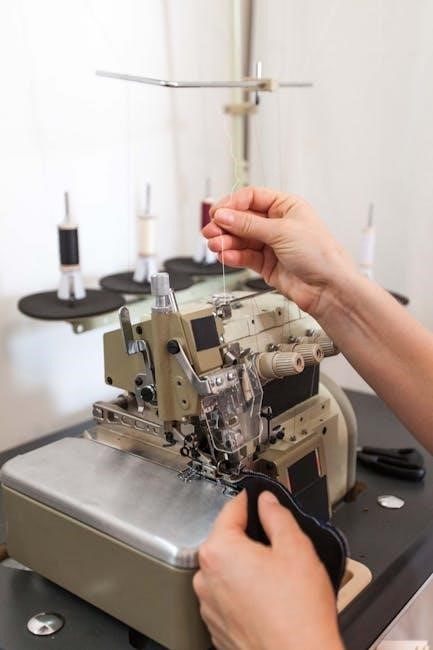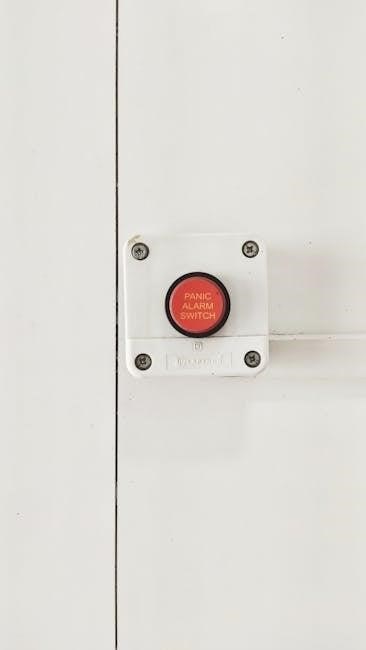The Honeywell Economizer Controller, specifically the JADE W7220 module, is a advanced HVAC control system designed to optimize energy efficiency by utilizing outdoor air for cooling, reducing mechanical cooling demands, and integrating with sensors and actuators for precise environmental control․
1․1 Overview of the Honeywell Economizer Controller
The Honeywell Economizer Controller, specifically the JADE W7220 module, is a sophisticated system designed to optimize HVAC energy efficiency․ It operates as a standalone unit or integrates with advanced sensors for enhanced functionality․ The module features an LCD display and keypad for user interaction, automatically detecting connected sensors and indicating failures․ It supports optional components like CO2 sensors and damper actuators, enabling precise control of outdoor air usage for free cooling․ This system is expandable, allowing for tailored configurations to meet specific HVAC requirements, ensuring optimal performance and energy savings․
1․2 Importance of Economizer Controllers in HVAC Systems
Economizer controllers play a crucial role in HVAC systems by optimizing energy consumption and reducing operational costs․ They enable systems to use outdoor air for cooling when conditions are favorable, lowering the need for mechanical cooling․ This not only enhances energy efficiency but also improves indoor air quality by introducing fresh air․ Honeywell’s advanced controllers, like the JADE W7220, integrate seamlessly with sensors and actuators, providing precise control and adaptability to varying environmental conditions․ Their ability to automate and regulate airflow ensures consistent comfort while minimizing energy usage, making them essential for modern HVAC applications․

System Components
The Honeywell Economizer Controller system includes the JADE W7220 module, optional CO2 and mixed air sensors, damper actuators for airflow control, and Sylk Bus sensors for advanced monitoring, ensuring efficient HVAC operation and environmental regulation․
2․1 JADE W7220 Economizer Module
The JADE W7220 Economizer Module is the central component of Honeywell’s economizer control system, designed to optimize HVAC efficiency․ It features an LCD display and keypad for user interaction, enabling configuration and monitoring of economizer functions․ The module can operate as a stand-alone controller, directly connected to outdoor air sensors, or integrate with Sylk Bus sensors for advanced functionality․ It automatically detects connected sensors and actuators, ensuring seamless communication and operation․ The W7220 supports both dry-bulb and enthalpy-based economizer strategies, providing flexible solutions for energy-efficient HVAC control;
2․2 Optional Sensors for Enhanced Functionality
Optional sensors, such as CO2, enthalpy, and mixed air temperature sensors, enhance the Honeywell Economizer Controller’s functionality․ These sensors provide precise data on indoor air quality, humidity, and temperature, enabling advanced control strategies like demand control ventilation (DCV)․ The C7232 CO2 sensor and C7400 enthalpy sensor can be integrated via Sylk Bus or analog connections, offering flexibility․ Up to three Sylk Bus sensors can be connected, allowing for differential enthalpy control․ These sensors improve system efficiency and indoor comfort while ensuring compliance with energy-saving strategies․
2․3 Damper Actuators and Their Role
Damper actuators, such as the Honeywell MS3103J and MS7503 models, are essential for controlling outdoor air dampers in HVAC systems․ These actuators directly connect to the W7220 Economizer Module, enabling precise modulation of damper positions to regulate airflow․ They ensure optimal outdoor air intake for free cooling, improving energy efficiency and maintaining indoor air quality․ Available in both direct-coupled and communicating configurations, these actuators provide reliable and accurate control, adapting to system demands for enhanced performance and comfort․
2․4 Sylk Bus Sensors for Advanced Control
Sylk Bus sensors, including the C7400S enthalpy and C7250A temperature sensors, integrate seamlessly with the W7220 module, enhancing control capabilities․ These sensors provide precise measurements of temperature, humidity, and enthalpy, enabling advanced economizer functions like differential enthalpy control․ They communicate directly over the Sylk Bus, simplifying wiring and ensuring reliable data transmission․ Up to three sensors can be connected, allowing for comprehensive monitoring of outdoor and return air conditions, which optimizes economizer performance and energy savings in HVAC systems․
Installation and Setup
The JADE W7220 module requires careful installation, starting with pre-installation checks and mounting in an accessible location․ Wiring involves connecting sensors, actuators, and power sources, ensuring all terminals are securely fastened․ The PCMOD interface tool is essential for configuration, allowing users to set parameters and test the system․ Proper setup ensures optimal performance and integration with HVAC systems, leveraging advanced features like Sylk Bus communication for enhanced control․
3․1 Pre-Installation Requirements
Before installing the Honeywell JADE W7220 Economizer Module, ensure the site meets specific requirements․ The module must be mounted in a dry, cool location, protected from direct sunlight and moisture․ Verify that all necessary components, such as sensors, actuators, and wiring, are available and compatible․ Ensure power supply matches the module’s specifications (24 VAC)․ Familiarize yourself with the installation manual and ensure the PCMOD interface tool is ready for configuration․ Proper preparation ensures a smooth installation process and optimal system performance․ Compliance with local electrical codes is mandatory for safety and functionality․
3․2 Mounting the Economizer Module
The Honeywell JADE W7220 Economizer Module must be mounted securely in a dry, cool location to ensure proper operation․ The module can be installed on a flat surface or in a duct using the provided mounting hardware․ For sheet metal installation, use self-tapping screws, while the duct mounting kit (part number 50053060-001) is required for in-duct applications․ Ensure the module is positioned away from direct sunlight and moisture to prevent damage․ A stable and secure installation is critical for accurate sensor readings and reliable system performance․ Follow all safety guidelines and manufacturer recommendations for optimal results․
3․3 Wiring the System
Wiring the Honeywell JADE W7220 Economizer Module involves connecting sensors, actuators, and power sources․ Begin by wiring the sensors, such as the mixed air and outdoor air temperature sensors, to the module’s designated terminals․ Next, connect the damper actuators, ensuring proper polarity and voltage compatibility․ The module’s terminal blocks accommodate wires of various gauges․ Follow the wiring diagrams provided in the manual for specific connections, such as AUX1, AUX2, and R terminals․ Ensure all connections are secure to prevent loose wires․ Refer to the wiring application examples in the manual for detailed configurations․ Proper wiring ensures reliable system operation and accurate sensor communication․ Use the duct mounting kit (part number 50053060-001) if installing sensors in the duct․ Always follow safety guidelines to avoid electrical hazards․
3․4 Wiring Application Examples
Wiring application examples for the Honeywell JADE W7220 Economizer Module include stand-alone dry-bulb configurations and advanced setups with Sylk Bus sensors․ In a stand-alone configuration, wire the module directly to sensors, actuators, and mechanical cooling controls․ For enthalpy control, connect Sylk Bus sensors to measure outdoor and return air conditions․ The module supports up to three Sylk Bus sensors for enhanced functionality; Examples include wiring the MS3103J or MS3105J actuators for damper control and integrating CO2 or IAQ sensors for demand control ventilation․ These wiring examples provide clear guidance for configuring the system to meet specific economizer requirements․

Configuration and Setup
The Honeywell JADE W7220 Economizer Module features an intuitive interface with an LCD and keypad for easy configuration․ The menu structure allows users to set parameters, enabling economizer functions like dry-bulb or enthalpy control, and integrates with optional sensors for advanced operation․
4․1 Interface Overview
The Honeywell JADE W7220 Economizer Module boasts a user-friendly interface with an LCD display and keypad, simplifying configuration and operation․ The interface allows users to navigate through menus, adjust parameters, and monitor system status․ The LCD provides clear feedback on economizer functionality, including outdoor air temperature, mixed air conditions, and system errors․ The keypad enables easy navigation and parameter adjustments, ensuring seamless control over economizer operations․ This intuitive design facilitates efficient setup and troubleshooting, making it accessible for both experienced technicians and new users․ The interface is central to the module’s functionality, ensuring precise control and monitoring of HVAC systems․
4․2 Menu Structure and Parameter Configuration
The Honeywell JADE W7220 Economizer Module features a hierarchical menu structure for easy navigation and configuration․ Users can access parameters such as temperature setpoints, damper positions, and economizer modes through the LCD interface․ Key parameters include ECON AVAIL (economizing availability) and ECONOMIZING (active outdoor air usage)․ The menu allows customization of thresholds for outdoor air temperature and humidity, enabling precise control over when to engage free cooling․ Parameter adjustments are made using the keypad, with options to fine-tune settings for optimal energy efficiency and system performance․ This intuitive configuration ensures seamless integration with HVAC systems․
4․3 Setting Up Sensors and Actuators
Setting up sensors and actuators on the Honeywell JADE W7220 Economizer Module involves connecting and configuring devices like temperature, humidity, and CO2 sensors, as well as damper actuators․ The module automatically detects connected Sylk Bus sensors, simplifying setup․ Actuators are configured to control damper positions, ensuring proper outdoor air intake and exhaust․ Users can assign specific functions to each sensor and actuator through the menu interface, allowing for tailored system responses․ Proper calibration and testing ensure accurate operation, optimizing energy efficiency and maintaining desired indoor air quality․ This step is crucial for achieving reliable economizer performance․

Operation Modes
The Honeywell JADE W7220 Economizer Module operates in stand-alone dry-bulb or enthalpy control modes, optimizing outdoor air usage for energy efficiency and indoor air quality․
5․1 Stand-Alone Dry-Bulb Economizer Configuration
The stand-alone dry-bulb economizer configuration operates independently, using outdoor air temperature to determine if free cooling is available․ It connects directly to a commercial thermostat and sensors, providing basic economizer functionality without advanced features․ This mode is ideal for simple HVAC systems, optimizing energy savings by reducing mechanical cooling when outdoor conditions allow․ The W7220 module controls dampers and stages of cooling based on temperature thresholds․ While efficient, it does not account for humidity, making it suitable for applications where dry-bulb temperature is the primary control parameter․ This configuration is straightforward and cost-effective for smaller systems․
5․2 Enthalpy Control with Sylk Bus Sensors
Enthalpy control with Sylk Bus sensors enhances economizer functionality by measuring both temperature and humidity, enabling precise control of outdoor and return air․ The W7220 module integrates with Sylk Bus sensors, automatically detecting and configuring up to three sensors for advanced control․ This setup allows for differential enthalpy comparison, optimizing free cooling while maintaining indoor humidity levels․ The system supports demand control ventilation (DCV) and provides real-time feedback, ensuring efficient energy use․ This mode is ideal for applications requiring both temperature and humidity management, offering superior performance compared to dry-bulb configurations․

Maintenance and Troubleshooting
Regularly inspect sensors, clean dampers, and verify wiring connections․ Check for Sylk Bus communication errors and address sensor or actuator malfunctions promptly to ensure optimal performance․
6․1 Routine Maintenance Tasks
Regular maintenance ensures optimal performance of the Honeywell Economizer Controller․ Inspect sensors for cleanliness and accuracy, especially temperature and humidity sensors․ Verify wiring connections and check for wear or damage․ Clean damper blades and actuators to prevent mechanical issues․ Use the W7220’s LCD interface to monitor system status and address any error messages promptly․ Replace faulty components and ensure proper communication on the Sylk Bus․ Schedule routine checks to maintain efficiency and prevent unexpected downtime in HVAC operations․
6․2 Common Issues and Solutions
Common issues with the Honeywell Economizer Controller include sensor communication errors, incorrect damper actuator responses, and wiring faults․ For sensor issues, ensure connections are secure and verify Sylk Bus communication․ If a sensor loses communication, the module will display an error, requiring a reset or replacement․ Damper actuators may malfunction due to improper calibration; use the module’s interface to test actuator operation․ Wiring problems can cause system malfunctions; check terminal connections and ensure proper wiring according to the manual․ Regularly inspect and clean components to prevent operational disruptions․
The Honeywell Economizer Controller offers a comprehensive solution for optimizing HVAC system performance, enhancing energy efficiency, and ensuring reliable operation through advanced control and integration capabilities․
7․1 Summary of Key Features
The Honeywell Economizer Controller, particularly the JADE W7220 module, features an intuitive LCD interface, keypad navigation, and compatibility with optional sensors like mixed air and outdoor air temperature sensors․ It supports both stand-alone dry-bulb economizer configurations and advanced enthalpy control using Sylk Bus sensors․ The module automatically detects connected sensors and provides real-time status updates, ensuring efficient operation․ It also integrates with damper actuators for precise control of outdoor air intake, optimizing energy savings and maintaining indoor air quality․ These features make it a robust solution for HVAC systems aiming to maximize efficiency and reduce energy consumption․
7․2 Benefits of Using Honeywell Economizer Controller
The Honeywell Economizer Controller offers significant energy savings by optimizing outdoor air usage, reducing reliance on mechanical cooling․ It enhances system efficiency through precise temperature and humidity control, ensuring optimal indoor air quality․ The module’s compatibility with various sensors and actuators allows for tailored solutions, while its user-friendly interface simplifies operation․ By automating economizer functions, it minimizes manual intervention and potential errors․ Additionally, the controller’s scalability and advanced features make it a cost-effective and environmentally friendly choice for modern HVAC systems, providing long-term operational and financial benefits․




About the author